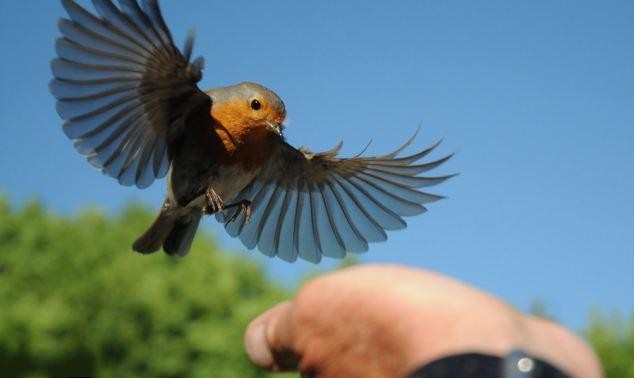英國 鳥類數量
Out of the woods
離開樹林
Good news on the bird population—but not for everyone
鳥類數量的捷報——但并非對所有人
City Slicker
城市人
British birdwatchers are used to bad news. House sparrow numbers have fallen from an estimated 30m to 10m since 1966. Curlews have become a rare sight, their numbers plummeting by 50% in 15 years. Cuckoos, once-frequent visitors from Africa, have declined by 63% in the south-east in the past two decades. Earlier springs that confuse migratory birds, more efficient farming and the conversion of dilapidated buildings (good for nesting) into modern homes have all contributed to these woes.
英國的觀鳥者已經對壞消息習以為常。自1966年以來,家養麻雀的數量已從約3000萬減少到1000萬。杓鷸的數量在十五年間銳減50%,變得越發罕見。過去二十年間,曾經經常從非洲遷徙至英國東南部的布谷鳥數量減少了63%。造成這種災患的原因包括迷惑候鳥的早春,更高效的耕種以及危房(適宜筑巢)向現代房屋的轉變。

But data released by the British Trust for Ornithology (BTO), a research charity, suggest some are soaring. Tracking bird populations by means of regular surveys, the figures give the clearest picture yet of 49 species acrossBritain.
但是公益性科研機構英國鳥類學基金會公布的數據顯示,有一些鳥類的數量卻扶搖而上。他們通過定期調查的方式追蹤群鳥,其數據清晰地描繪了目前全英49種鳥類的真實狀況。
Blackcaps, small woodland birds native to Germany and eastern Europe, are lingering after their summer sojourns: since 1967 numbers have increased by 177%. The little egret, a white heron-like bird, arrived from continental Europein 1989 and now numbers over 5,000. Wood pigeons, once found shyly cooing in forests, have boldly moved into cities and suburbs.
黑頂林鶯是來自德國和東歐地區的一種小型林棲鳥,在它們的夏季之旅后仍然流連忘返。自1967年以來,它們的數量增加了177%。小白鷺,一種白色的鷺科鳥類1989年從歐洲大陸而來,現在它們的數量已經突破5000. 原先只敢在樹林里低吟淺唱的斑尾林鴿已經勇敢地遷移到了城市和郊區。
Environmental and agricultural changes have helped as well as disoriented birds. Modern farming techniques allow grain to be sown in the autumn rather than the spring; that helps wood pigeons feed in winter. Warmer winters mean rivers and ponds are less likely to freeze, providing the little egrets with food. James Pearce-Higgins of the BTO says that blackcaps benefit particularly from the increasing popularity of berry bushes (such as rowan and yew) in people’s gardens.
環境和農業的變化既幫助了鳥類,也迷惑了它們。相較春天播種,現代的農業技術使秋天播種成為可能,這也為斑尾林鴿過冬提供保障。暖冬意味著河流與池塘難于冰凍,這給小白鷺提供了食物。英國鳥類信托基金的詹姆斯皮爾斯—希金斯說,人們花園中越來越多的漿果叢(諸如歐洲花楸和紫杉)令黑頂林鶯獲益良多。
These species and others benefit from the British love of bird feeders. “I would be amazed if anyone feeds garden birds inEuropeas much as we do,” says Stephen Moss, a nature writer. First sold in 1964 by the Royal Society for the Protection of Birds (RSPB), a charity with over1mmembers, bird feeders took off in the 1990s when food such as sunflower hearts and nyjer seeds became widely available and the RSPB began to encourage people to feed birds throughout the year. (The bird tables found in other northern European countries, such as Finland and Germany, tend to be stocked only during the winter.) In 1987 only 17 species availed themselves of British feeders; these days 86 do.
以上幾種和其他種類的鳥獲益于喂鳥者的英式關愛。“在歐洲,沒有人會像英國人一樣頻繁地在花園喂鳥了。”自然作家史提芬摩斯說。喂鳥器最早在1964年由皇家鳥類保護協會出售,該協會是有超過百萬會員的慈善組織。在90年代,葵花籽、薊花籽之類食品的廣泛普及,同時皇家鳥類保護協會鼓勵人們全年不休地喂鳥,喂鳥器的銷量突飛猛漲。(在北歐的一些國家,例如芬蘭和德國,喂鳥臺只在冬天發揮作用。)在1987年,只有17種鳥得到了喂鳥者的幫助,而今有86種。
Birders grouse nonetheless. Some of the species prospering, such as carrion crows and buzzards, are disliked. And migratory birds that extend their visits may provide competition for some avian natives. They are “muscling in and getting the first claim on breeding sites”, says Richard Cowser of the Sussex Ornithological Society. Like their human counterparts, residents of a small island buffeted by global winds, British birds will have to learn to compete.
然而怨聲隨之而起。一些不遭人喜歡的鳥也開始泛濫,比如食腐烏鴉和禿鷹。同時,逗留時間更長的候鳥也可能對一些本土鳥產生競爭。據蘇塞克斯鳥類學社團的理查德 考瑟所說,它們“強勢插入,占領繁殖地。”就如它們的人類伙伴一樣,小島上的居民被全球風席卷。英國的鳥類要學會競爭。翻譯:袁航












